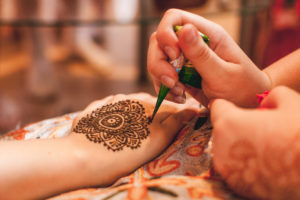
You might have seen henna body art before and were enamored with its gorgeous, intricate designs. However, you might not be aware of the cultural and religious origins behind this practice. As a fascinating tradition with older origins, the application and wearing of henna body designs continues today in many different parts of the world. Depending on the wearer’s faith and country of origin, the designs and the reasons behind are imbued with a wide variety of meanings.
Mehndi: A Classic Indian Matrimonial Tradition
When most people think about henna skin art, they’re likely to picture mehndi. According to the Sanskrit Dictionary, the term is derived from the Sanskrit word “mendhikā,” which refers to the plants traditionally used to create the temporary coloring. Specific to the Indian subcontinent, its roots lie in Hindu Vedic customs focused on “awakening the inner light.” Other sources, such as a 2012 article in Desh-Videsh Magazine, point to medicinal reasons for its application. Said to contain an antiseptic agent that improves blood circulation, mehndi designs were carefully painted onto engaged couples to protect them from illnesses prior to their wedding ceremonies.
Mehndi remains an important part of Hindu and some Sikh matrimonial traditions today. Two or three days before the primary nuptial festivities are held, the bride’s family hosts a mehndi ceremony. Huffington Post contributor Jafreen M. Uddin describes it as a special time of bonding for the bride and her closest female friends. After she and her confidants are decorated with elaborate patterns in henna, an informal night of feasting and celebration follows.
Henna Art Customs in Islam
There are no specific commandments calling for the obligatory use of henna body art in the Qur’an. Nevertheless, this practice has been woven into many Islamic cultures around the world, particularly in the Indian subcontinent, the Middle East and Africa. For Muslim women in India and Pakistan, it is part of Ramadan customs, especially during the Eid al-Fitr celebration that brings the holy month to a close. Huffington Post writer Yasmine Hafiz described Chaand Raat, or “Night of the Moon” traditions observed the day before the Eid holiday. In addition to shopping and preparing food for this special occasion, Muslim women will also get together to apply beautiful, lavish henna decorations to their hands. According to writer Noam Sienna of Ayiba Magazine, henna skin designs are also common throughout many predominantly Islamic regions in Africa. Generally, they are worn to commemorate the end of Ramadan or the birth of a child, or for wedding celebrations.
Some Men Wear Henna Body Art
While most wearers of henna skin designs have customarily been women, the practice is not necessarily limited by gender. Some debate whether men should be adorned with it, citing their interpretation of religious doctrines that prohibit men from dressing like women. However, these viewpoints are not universal and can vary according to the culture. For example, Noam Sienna documented in his Ayiba Magazine piece that both Hausa brides and grooms in sub-Saharan Africa are decorated with extensive designs a few days before their weddings. Additionally, a May 2017 Times of India article reported that Indian actor Ranbir Kapoor was spotted wearing henna designs in a recent film. Meanwhile, more men are following suit in receiving and wearing this unique, delicate body art.
A Product of Culture and Religion
As human history has repeatedly proven, many aspects of a civilization’s culture also share some origins, meanings or associations with religious beliefs and traditions. Henna body art has predominantly Indian roots, but its practice has spread throughout the Middle East, Africa and Western countries to which Hindu and Muslims have immigrated and resettled. With its focuses on beauty, joy and celebration, the art draws new admirers and remains strong and steady around the globe today.

